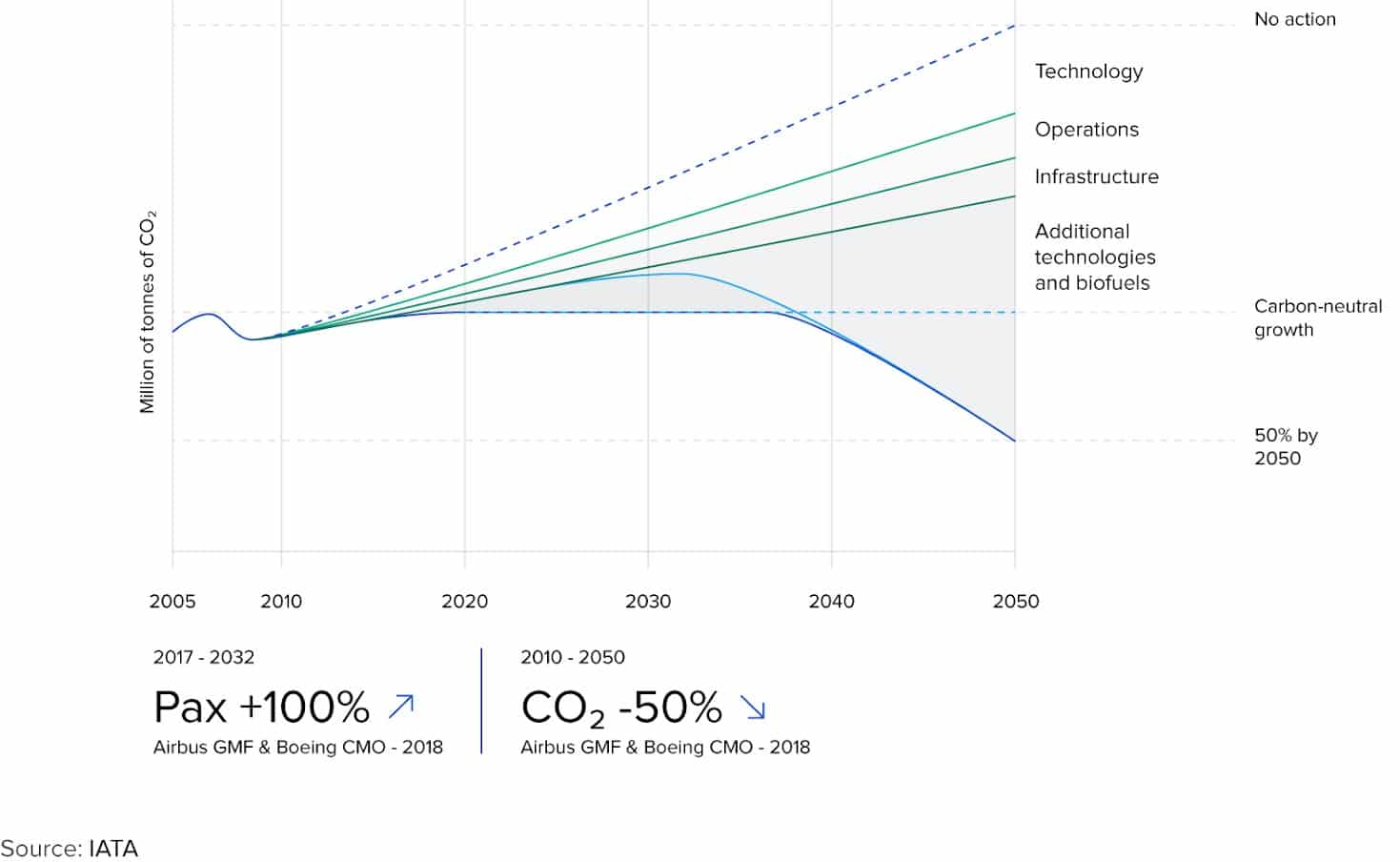Swedish startup Heart Aerospace is developing a next-generation solution to aviation carbon emissions with their new 30-seater electric plane.
Gothenburg-based Heart Aerospace is an electric airplane maker with the mission “to create the world’s greenest, most affordable, and most accessible form of transport”.
The company seeks to make electric air travel the new normal for regional flights. With the cost of electric planes dropping it will soon start to compete with traditional aircrafts as the industry evolves.
Electrifying Regional Air Travels
Airlines – and the aviation industry as a whole – have come under fire for their air pollution. By some estimates, air travel is accountable for 3% to 4% of all GHG emissions in the U.S.
The industry even has its own carbon credit scheme CORSIA.
Globally, the International Air Transport Association (IATA) forecasted the following scenario by 2050 for global aviation emissions.

Though airlines have different ways to address their emissions, electrifying air travel is one solution to reduce the sector’s climate impact. And while some experts say that commercial operation is still far down the line, electric or battery-powered planes are gaining more traction.
Introducing Heart Aerospace’s Electric Plane
Founded in 2018, Heart Aerospace has been developing a regional electric-hybrid plane named ES-30. It has a standard seating capacity of 30 passengers driven by electric motors with battery-derived power. It’s the manufacturer’s second prototype, after its 19-seater ES-19.
The ES-30 will have a fully electric zero emissions flight range of 200 kilometers. It also has an extended range of 400 km for 30 travelers. Better yet, it can fly up to 800 km with 25 passengers which includes typical airline reserves.

The ES-30 also flies more quietly than conventional airplanes for its fewer moving parts.
All these features combine with the possibility of decreasing costs due to lower fuel cost and maintenance. This will enable airline operators to offer new routes that were not viable before and bolster regional air travel.
The upgraded aircraft will be in full service in 2028.
Heart Aerospace’s founder and CEO, Anders Forslund, remarked that:
“We have designed a cost efficient airplane that allows airlines to deliver good service on a wide range of routes.. With the ES-30 we can start cutting emissions from air travel well before the end of this decade and the response from the market has been fantastic.”
He also noted that used to be hundreds of small planes serving a lot of communities that have now lost service. Small city residents prefer more to drive on trips of 250 miles rather than take a plane.
In fact, less than 1% of travelers making a 250-mile trip choose to fly as per estimates. That’s because jet engines made for planes were too expensive today to serve them profitably, according to Forslund.
With that said, an executive from the United Airlines pointed out that a small city will either get service they didn’t have before or they’ll have a greater frequency of service. This will allow travelers from smaller cities to fly in and out on the same day, which was not possible with traditional jet powered planes.
- In particular, some estimates suggest that an electric plane can have a 90% reduction in fuel costs and 50% lower maintenance than a fossil fuel-powered plane.
These decreased costs will be a big plus to the $26 billion short-haul air travel market, consisting ~30% of all flights. In effect, there will be more service between smaller regional airports that are uneconomical right now.
Add to this the 66% quieter movements and zero tailpipe emissions of electric planes. Hence, the likes of ES-30 will be cheaper to run than traditional jet engines within a decade as the industry evolves, experts say.
With such a revolutionary electric aircraft design, ES-30 draws a lot of attention and money.
Who’s Dipping Their Wings Into Electric Planes?
Heart Aerospace is not only attracting some of the world’s largest investors such as the Breakthrough Energy Ventures, EQT Ventures, European Investment Council, and Lower Carbon Capital. The electric plane maker has also won the trust of major industry players around the world, including:
- Mesa Air Group Inc.,
- United Airlines,
- Air Canada, and
- Swedish aerospace and defense company Saab
Last September, both Air Canada and Saab confirmed holding minority stakes in Heart Aerospace. Each company invested US$5 million in the startup.
The North America’s largest airlines also placed a purchase order for 30 ES-30 units. Air Canada’s President and CEO Michael Rousseau commented that:
“We have been working hard with much success to reduce our footprint, but we know that meeting our net-zero emissions goals will require new technology such as the ES-30. We have every confidence that the team at Heart Aerospace has the expertise to deliver on the ES-30’s promise of a cleaner and greener aviation future.”
United Airlines and Mesa Air Group also placed previous orders for ES-19 units for a total of 200 with an option for an additional 100 planes. But they’re reconfirmed for the updated ES-30 design.
Apart from those commitments, plenty of other holders of Letter of Intent (LOI) for ES-19 have also updated their intent to go for ES-30. They include:
- Nordic airlines Braathens Regional Airlines (BRA),
- Icelandair
- Scandinavian Airlines SAS
- New Zealand’s Sounds Air
- Swedish-based lessor Rockton
Portuguese airline Sevenair also signed an LOI to buy ES-30s. With this latest interest, Heart Aerospace has a total of 230 orders and 100 options for its electric plane, along with LOIs for 99 planes.
With lower costs and zero carbon emissions, the business case for electric planes with the promise for cleaner aviation seems to be taking off.

